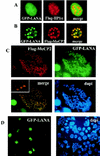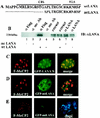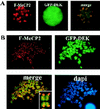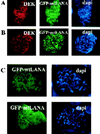Protein interactions targeting the latency-associated nuclear antigen of Kaposi's sarcoma-associated herpesvirus to cell chromosomes
- PMID: 12388720
- PMCID: PMC136775
- DOI: 10.1128/jvi.76.22.11596-11604.2002
Protein interactions targeting the latency-associated nuclear antigen of Kaposi's sarcoma-associated herpesvirus to cell chromosomes
Abstract
Maintenance of Kaposi's sarcoma-associated herpesvirus (KSHV) latent infection depends on the viral episomes in the nucleus being distributed to daughter cells following cell division. The latency-associated nuclear antigen (LANA) is constitutively expressed in all KSHV-infected cells. LANA binds sequences in the terminal repeat regions of the KSHV genome and tethers the viral episomes to chromosomes. To better understand the mechanism of chromosomal tethering, we performed glutathione S-transferase (GST) affinity and yeast two-hybrid assays to identify LANA-interacting proteins with known chromosomal association. Two of the interactors were the methyl CpG binding protein MeCP2 and the 43-kDa protein DEK. The interactions of MeCP2 and DEK with LANA were confirmed by coimmunoprecipitation. The MeCP2-interacting domain was mapped to the previously described chromatin binding site in the N terminus of LANA, while the DEK-interacting domain mapped to LANA amino acids 986 to 1043 in the C terminus. LANA was unable to associate with mouse chromosomes in chromosome spreads of transfected NIH 3T3 cells. However, LANA was capable of targeting to mouse chromosomes in the presence of human MeCP2 or DEK. The data indicate that LANA is tethered to chromosomes through two independent chromatin binding domains that interact with different protein partners.
Figures








Similar articles
-
Bub1 and CENP-F can contribute to Kaposi's sarcoma-associated herpesvirus genome persistence by targeting LANA to kinetochores.J Virol. 2010 Oct;84(19):9718-32. doi: 10.1128/JVI.00713-10. Epub 2010 Jul 21. J Virol. 2010. PMID: 20660191 Free PMC article.
-
Kaposi's sarcoma herpesvirus C-terminal LANA concentrates at pericentromeric and peri-telomeric regions of a subset of mitotic chromosomes.Virology. 2007 Jan 20;357(2):149-57. doi: 10.1016/j.virol.2006.07.052. Epub 2006 Sep 18. Virology. 2007. PMID: 16979209
-
The latency-associated nuclear antigen interacts with MeCP2 and nucleosomes through separate domains.J Virol. 2010 Mar;84(5):2318-30. doi: 10.1128/JVI.01097-09. Epub 2009 Dec 23. J Virol. 2010. PMID: 20032179 Free PMC article.
-
Kaposi's Sarcoma-Associated Herpesvirus Latency-Associated Nuclear Antigen: Replicating and Shielding Viral DNA during Viral Persistence.J Virol. 2017 Jun 26;91(14):e01083-16. doi: 10.1128/JVI.01083-16. Print 2017 Jul 15. J Virol. 2017. PMID: 28446671 Free PMC article. Review.
-
KSHV LANA--the master regulator of KSHV latency.Viruses. 2014 Dec 11;6(12):4961-98. doi: 10.3390/v6124961. Viruses. 2014. PMID: 25514370 Free PMC article. Review.
Cited by
-
Herpesvirus saimiri episomal persistence is maintained via interaction between open reading frame 73 and the cellular chromosome-associated protein MeCP2.J Virol. 2007 Apr;81(8):4021-32. doi: 10.1128/JVI.02171-06. Epub 2007 Jan 31. J Virol. 2007. PMID: 17267510 Free PMC article.
-
Molecular genetics of Kaposi's sarcoma-associated herpesvirus (human herpesvirus-8) epidemiology and pathogenesis.Microbiol Mol Biol Rev. 2003 Jun;67(2):175-212, table of contents. doi: 10.1128/MMBR.67.2.175-212.2003. Microbiol Mol Biol Rev. 2003. PMID: 12794189 Free PMC article. Review.
-
Molecular biology of KSHV in relation to AIDS-associated oncogenesis.Cancer Treat Res. 2007;133:69-127. doi: 10.1007/978-0-387-46816-7_3. Cancer Treat Res. 2007. PMID: 17672038 Free PMC article. Review.
-
Localization and dynamics of small circular DNA in live mammalian nuclei.Nucleic Acids Res. 2004 May 11;32(8):2642-51. doi: 10.1093/nar/gkh587. Print 2004. Nucleic Acids Res. 2004. PMID: 15141035 Free PMC article.
-
Proteomic analysis of the Kaposi's sarcoma-associated herpesvirus terminal repeat element binding proteins.J Virol. 2006 Sep;80(18):9017-30. doi: 10.1128/JVI.00297-06. J Virol. 2006. PMID: 16940514 Free PMC article.
References
-
- An, J., A. K. Lichtenstein, G. Brent, and M. B. Rettig. 2002. The Kaposi sarcoma-associated herpesvirus (KSHV) induces cellular interleukin 6 expression: role of the KSHV latency-associated nuclear antigen and the AP1 response element. Blood 99:649-654. - PubMed
-
- Antequera, F., and A. Bird. 1993. CpG islands, p. 169-185. In J. Jost and H. Saluz (ed.), DNA methylation: molecular biology and biological significance. Birkhauser Verlag, Basel, Switzerland.
-
- Ballestas, M. E., P. A. Chatis, and K. M. Kaye. 1999. Efficient persistence of extrachromosomal KSHV DNA mediated by latency-associated nuclear antigen. Science 284:641-644. - PubMed
Publication types
MeSH terms
Substances
Grants and funding
LinkOut - more resources
Full Text Sources
Molecular Biology Databases
Research Materials
Miscellaneous

